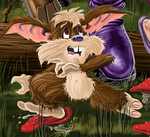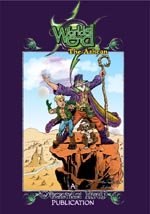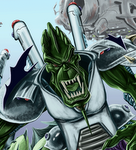Comics and Graphic Novels - The Misconception
I have always believed that comics and now graphic novels have had the ability to teach children and folks that have never learnt to read to do so. Throughout my time in the education system, of which I am now a part of, in a small way, I came to realise that the teachers looked at comics as a reading material for those in society of only a semi-literate non-academic bearing. I think this has also been true of the perceptions of the general public too.
Comics, in these terms, equate to kids humour comics and at best only serve as juvenile entertainment, with a mountain of custard pies being thrown and slapstick humour throughout their covers. To most people this is what comics are about. Even with the advent of the big budget comics related films, now being produced in the last thirty or so years, the general public’s view of even this superhero genre has just been of men in tights – or spandex as we now call their costumes.
This is not the true nature of comics and their sequential art and in fact has never been true. Newspapers used to have adventure strips in their pages. Titles such as, Prince Valiant and Tarzan from the USA and Garth and Jeff Hawke from here in the UK, amongst many others, abounded. Starting in the late nineteen seventies the actual space in the newspapers used for the strips began to be cut back and then shrunk until there is now hardly any action and adventure strip work produced at all.
The only real chance of producing strip work nowadays for the syndicates is to work on a humour strip. But it was the people buying the papers that were reading the adventure strips; James Bond and Modesty Blaze are two other high profile characters that spring to mind. The children only read the strips when Mum and Dad came home with their newspapers, handing the strip pages over to their children.
My own views and those of most folks working in the business of comics and now graphic novels is, however quite different. This is not down to a need to prove their worth, but rather a true understanding of the nature of their construction and of the teaching and learning values of storytelling techniques. The exact same kinds of techniques are used in producing novels, children’s books, magazine features, film, television and theatre scripts, etc, etc.
Humans have created and listened in awe to stories from the dawn of mankind using language to communicate…we now read these stories as myth and legends, faerie tales, even books of a religious nature.
The storytelling tradition started even before mankind began to write them down, firstly as pictures, which developed into the hieroglyph form and later into the alphabets and scripts used throughout the world today. These early stories were passed on orally from generation to generation by the storytellers of the time. Some of these stories served as morality pieces, whilst others kept the status quo with the adult population and also with children too, helping to enforce the rules of the time with tales of what would happen if they were not adhered to.
As mankind has become more academically minded the books and works of fiction and fact have become increasingly sophisticated. This added to the fact that children are perceived, as going through a process of education is partly to blame for the misconception that comics and now graphic novels are all just juvenile entertainment.
If one looks at some of the language used in say the humour comics of the UK, whilst it could be argued the language is quite simply used, with only an occasional use of a “big” word, it cannot be denied that the child reading the comic is doing just that…reading.
This is exactly what is needed to educate and the fact that it is a comic and not a book is irrelevant, as the child in question is reading and thus still being educated. If this is encouraged, eventually the child will wish to read and thus learn more and will move on to books and the older readers comics and graphic novels for the older readers.
From my experience as a pupil at junior school and then my early life in secondary school I remember reading such words as Genocide, Benevolence, Malevolence, Maniacal, Metamorphosis, Metaphysical and many more. Now for a kid between the ages of say 8 –12 that’s not bad, to say that they were contained in the pages of comic books. They certainly helped me when writing work for my English language and literature classes, whilst at school.
All this said, at long last there seems to be an increasing amount of academics and indeed the general public that are coming around to the fact that, like my fellow creators and myself, they too see the as to yet unused potential of the sequential art form, now known as comics and graphic novels.
The sheer volume of books now being bought in this digital age, where we are constantly told by governments and educators that literacy, numeracy and obesity are rife in our society, proves that they are succeeding in engaging the reader. Graphic novels have grown as a part of the book buying marketplace so much in the last few years that even book shops like WH Smith, Borders, and Waterstones, to name but a few in the UK, have taken notice and now have large sections of their stores dedicated to these new books. Now even more welcome is the fact that libraries are also seeing the vast merit of this area of reading.
Manga, comic books from Japan, are increasingly being read by the youths of today, outside of Japan, with a larger split in favour of girls reading them. Something we don’t see as much with American comics. Manga like originated western graphic novels are being increasingly added to the reading lists of libraries and bought by an ever-increasing amount of young girls and women. Graphic novel reading groups are sprouting up all over, as this growing section of the world’s book marketplace garners more and more interest.
At last the mere fact that pictures accompanying the words (part of the reason for the popular misconception that they are for kids only) and the dual standards that it is okay for adults to look at non-fiction books containing pictures and newspapers, which rely heavily on photographs and pictures to convey the message across to their readers, is now being reanalysed.
There is a place for the less wordy humour and early learning comic book alongside the storybooks we all know and love. There is also a place for the more wordy comic adventure books and graphic novels. With all the myriad genres and age ranges we now stand at the edge of a plateau looking out over the marvellous vistas that beckon from beyond. Whilst most people will never visit certain parts of this world and indeed any of the others that lie in deep space many miles from us on our piece of rock these comics and graphic novels give everyone the opportunity to do so.
If the young reader or indeed anyone unable to read at a later stage of life is given the opportunity they too can be given this freedom. To deny this is a worse case of cruelty against ones fellow man. Age and ability should hold no sway in this and in fact the opposite should be the case as we try to encourage everyone to read and visit these far away places or even our own doorstep.
I leave you with this thought, imagine if you are a reader and you were to suddenly never have been able to read, what wonders you would miss out on…no Treasure Island, no Robin Hood, no King Arthur, no War of the Worlds, no Little Women, no Peter Pan, no Wizard of Oz, no Anne of Green Gables, no Gulliver’s Travels, no Lord of the Rings, no Kidnapped, no Snow White, no Rip Van Winkle, no Robinson Crusoe, no Alice in Wonderland, no Christmas Carol, no Sherlock Holmes, no Tarzan, no Wind in the Willows, no Macbeth…
The above list has not even dented the full list. There are some people that through no fault of their own have been denied these things…if comics and later graphic novels enable them to change this and let them too see the wonderful worlds within, who are we to deny them that right…
Tim Perkins
November 3rd 2006
How to search this blog
2 months ago












































No comments:
Post a Comment